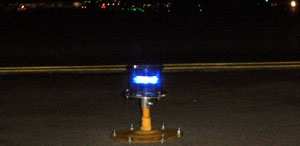Thu, Aug 11, 2011
LED Lighting Will Improve Safety At Far North BC Airfield
The Northern Canadian Tsay Keh Dene First Nation is outfitting a
remote airfield with solar LED lighting systems provided by
Carmanah Technologies. The new airfield lights will help supply and
medevac aircraft navigate their way to and from the remote village
located on the northern end of the Williston Reservoir, British
Columbia. The solar-powered airfield project was one of two
projects funded by the Canadian Government’s Innovative Clean
Energy Fund. The new completely solar-powered airfield is the first
of its kind in British Columbia.
Carmanah LED Runway Light File
Photo

Tsay Keh Dene First Nation, a rural Canadian First Nations
community, relies on a 4500ft runway to move supplies, groceries,
and community members to nearby towns. One of the runway’s
most critical uses is medical evacuation. With the closest hospital
over 5 hours away by logging road, the Community is dependent on
air transport for medical evacuations and supplies. The absence of
runway edge and threshold lighting after dusk meant that the
Community would have to wait until morning before medevac crews
could arrive. The deployment of Carmanah solar LED airfield lights
now provides the Community and neighbouring communities of
Williston Reservoir a safe runway after dusk for air traffic and
the supplies or community members being transported.
Tsay Keh Dene Chief Dennis Izony said that the solar-powered
airfield project is one that the community has requested for some
time. “We discuss improvements at Community meetings, and the
airfield lighting project always comes up. It was a fast and simple
solution for something that will greatly benefit the safety of the
community and pilots.”

Carmanah Solar LED Airfield Lighting systems are used in remote
and extreme environments where reliability and trouble-free
operation are required. According to Ted Lattimore, Carmanah CEO,
“The Tsay Keh Dene Nation represents the first installation
of a deployable solar-powered runway in British Columbia, yet given
the abundance of rural airfields that service communities
throughout Northern Canada, it won’t be the last. We
couldn’t anticipate a more appropriate application for these
lights.”
Tsay Keh Dene Nation member, Stacey Pierre, advises others
communities considering deploying solar-powered airfield lights for
their remote runways: “If you‘re in a remote community,
we would highly encourage it - for the safety of the
community.”
More News
Aero Linx: Transport Canada We are a federal institution, leading the Transport Canada portfolio and working with our partners. Transport Canada is responsible for transportation p>[...]
Gross Navigation Error (GNE) A lateral deviation from a cleared track, normally in excess of 25 Nautical Miles (NM). More stringent standards (for example, 10NM in some parts of th>[...]
From AirVenture 2017 (YouTube Edition): Flight-Proven Booster On Display At AirVenture… EAA AirVenture Oshkosh is known primarily as a celebration of experimental and amateu>[...]
Aircraft Parachute System (CAPS) Was Deployed About 293 Ft Above Ground Level, Which Was Too Low To Allow For Full Deployment Of The Parachute System Analysis: The day before the a>[...]
Also: 48th Annual Air Race Classic, Hot Air Balloon Fire, FAA v Banning 100LL, Complete Remote Pilot The news Piper PA-18 Super Cub owners have been waiting for has finally arrived>[...]
 ANN's Daily Aero-Linx (06.29.25)
ANN's Daily Aero-Linx (06.29.25) ANN's Daily Aero-Term (06.29.25): Gross Navigation Error (GNE)
ANN's Daily Aero-Term (06.29.25): Gross Navigation Error (GNE) Classic Aero-TV: Anticipating Futurespace - Blue Origin Visits Airventure 2017
Classic Aero-TV: Anticipating Futurespace - Blue Origin Visits Airventure 2017 NTSB Final Report: Cirrus SR22
NTSB Final Report: Cirrus SR22 Airborne Affordable Flyers 06.26.25: PA18 Upgrades, Delta Force, Rhinebeck
Airborne Affordable Flyers 06.26.25: PA18 Upgrades, Delta Force, Rhinebeck




